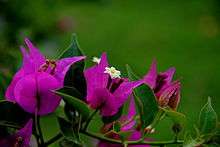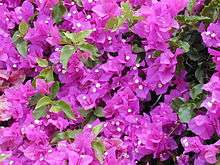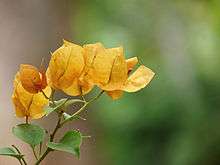Bougainvillea
| Bougainvillea | |
|---|---|
 | |
| Bougainvillea spectabilis | |
| Scientific classification | |
| Kingdom: | Plantae |
| (unranked): | Angiosperms |
| (unranked): | Eudicots |
| (unranked): | Core eudicots |
| Order: | Caryophyllales |
| Family: | Nyctaginaceae |
| Genus: | Bougainvillea Comm. ex Juss.[1] |
| Species | |
|
| |
| Synonyms | |
Bougainvillea (/ˌbuːɡᵻnˈvɪliə/ or /ˌboʊɡᵻnˈvɪliə/) is a genus of thorny ornamental vines, bushes, and trees with flower-like spring leaves near its flowers. Different authors accept between four and 18 species in the genus. They are native plants of South America from Brazil west to Peru and south to southern Argentina (Chubut Province). Bougainvillea are also known as buganvilla (Spain), bugambilia (Mexico, Guatemala, Cuba, Philippines), pokok bunga kertas (Indonesia), "'bougenville"' (Pakistan), Napoleón (Honduras), veranera (Colombia, Nicaragua, El Salvador, Costa Rica and Panama), trinitaria (Colombia, Panama, Puerto Rico, Dominican Republic & Venezuela), Santa Rita (Argentina, Bolivia, Brazil, Paraguay and Uruguay) or papelillo (northern Peru).
The vine species grow anywhere from 1 to 12 m (3 to 40 ft.) tall, scrambling over other plants with their spiky thorns. The thorns are tipped with a black, waxy substance. They are evergreen where rainfall occurs all year, or deciduous if there is a dry season. The leaves are alternate, simple ovate-acuminate, 4–13 cm long and 2–6 cm broad. The actual flower of the plant is small and generally white, but each cluster of three flowers is surrounded by three or six bracts with the bright colours associated with the plant, including pink, magenta, purple, red, orange, white, or yellow. Bougainvillea glabra is sometimes referred to as "paper flower" because the bracts are thin and papery. The fruit is a narrow five-lobed achene.
Bougainvillea are relatively pest-free plants, but they may suffer from worms, snails and aphids. The larvae of some Lepidoptera species also use them as food plants, for example the giant leopard moth (Hypercompe scribonia).
History
The first European to describe these plants was Philibert Commerçon, a botanist accompanying French Navy admiral and explorer Louis Antoine de Bougainville during his voyage of circumnavigation of the Earth, and first published for him by Antoine Laurent de Jussieu in 1789.[2] It is possible that the first European to observe these plants was Jeanne Baré, Commerçon's lover and assistant who was an expert in botany. Because she was not allowed on ship as a woman, she disguised herself as a man in order to make the journey (and thus became the first woman to circumnavigate the globe).[3]
Twenty years after Commerçon's discovery, it was first published as 'Buginvillæa' in Genera Plantarum by A.L. de Jussieu in 1789.[4] The genus was subsequently spelled in several ways until it was finally corrected to 'Bougainvillea' in the Index Kewensis in the 1930s. Originally, B. spectabilis and B. glabra were hardly differentiated until the mid-1980s when botanists recognized them to be totally distinct species. In the early 19th century, these two species were the first to be introduced into Europe, and soon, nurseries in France and England did a thriving trade providing specimens to Australia and other faraway countries. Meanwhile, Kew Gardens distributed plants it had propagated to British colonies throughout the world. Soon thereafter, an important event in the history of bougainvillea took place with the discovery of a crimson specimen in Cartagena, Colombia, by Mrs. R.V. Butt. Originally thought to be a distinct species, it was named B. buttiana in her honour. However, it was later discovered to be a natural hybrid of a variety of B. glabra and possibly B. peruviana - a "local pink bougainvillea" from Peru. Natural hybrids were soon found to be common occurrences all over the world. For instance, around the 1930s, when the three species were grown together, many hybrid crosses were created almost spontaneously in East Africa, India, the Canary Islands, Australia, North America, and the Philippines.
Cultivation and uses

Bougainvilleas are popular ornamental plants in most areas with warm climates. Locarno in Switzerland, with its mild Mediterranean climate, is famous for its bougainvilleas.
Although it is frost-sensitive and hardy in USDA Hardiness Zones 9b and 10, bougainvillea can be used as a houseplant or hanging basket in cooler climates. In the landscape, it makes an excellent hot season plant, and its drought tolerance makes it ideal for warm climates year-round. Its high salt tolerance makes it a natural choice for color in coastal regions. It can be pruned into a standard, but is also grown along fence lines, on walls, in containers and hanging baskets, and as a hedge or an accent plant. Its long arching thorny branches bear heart-shaped leaves and masses of papery bracts in white, pink, orange, purple, and burgundy. Many cultivars, including double-flowered and variegated, are available.
Many of today's bougainvillea are the result of interbreeding among only three out of the eighteen South American species recognized by botanists. Currently, there are over 300 varieties of bougainvillea around the world. Because many of the hybrids have been crossed over several generations, it is difficult to identify their respective origins. Natural mutations seem to occur spontaneously throughout the world; wherever large numbers of plants are being produced, bud-sports will occur. This had led to multiple names for the same cultivar (or variety) and has added to the confusion over the names of bougainvillea cultivars.
The growth rate of bougainvilleas varies from slow to rapid, depending on the variety. They tend to flower all year round in equatorial regions. Elsewhere, they are seasonal, with bloom cycles typically four to six weeks. Bougainvilleas grow best in dry soil, in very bright full sun and with frequent fertilization; but they require little water once established, and in fact will not flourish if over-watered. They can be easily propagated via tip cuttings.[5]
The bougainvillea is also a very attractive species for Bonsai enthusiasts, due to their ease of training and their radiant flowering during the spring.[6] They can be kept as indoor houseplants in temperate regions and kept small by bonsai techniques.
The hybrid cultivar B. × buttiana 'Poulton's Special' has gained the Royal Horticultural Society's Award of Garden Merit.[7]
Symbolism and nomenclature
Various species of Bougainvillea are the official flowers of Guam (where it is known as the Puti Tai Nobiu);[8] Lienchiang and Pingtung Counties in Taiwan; Ipoh, Malaysia;[9] the cities of Tagbilaran, Philippines; Camarillo, California; Laguna Niguel, California; San Clemente, California; the cities of Shenzhen, Huizhou, Zhuhai, and Jiangmen in Guangdong Province, China; and Naha, Okinawa.
Native to South America, Bougainvillea carries several names in the different regions where it is present. Apart from Rioplatense Spanish santa-rita and Peruvian Spanish papelillo, it may be variously named primavera, três-marias, sempre-lustrosa, santa-rita, ceboleiro, roseiro, roseta, riso, pataguinha, pau-de-roseira and flor-de-papel in Brazilian Portuguese. Nevertheless, buganvílea [buɡɐ̃ˈviʎ̟ɐ] in Portuguese and buganvilia [buɣamˈbilja] in Spanish are the most common names accepted by people of the regions where these languages are spoken but it is an introduced plant.
Toxicity
The sap of the Bougainvillea can cause serious skin rashes, similar to toxicodendron species.[10]
Selected species
- Bougainvillea × buttiana Holttum & Standl. (B. glabra × B. peruviana)[11]
- Bougainvillea glabra Choisy[11]
- Bougainvillea peruviana
- Bougainvillea spectabilis Willd.[11]
- Bougainvillea spinosa
Gallery
 Purple bougainvillea in Malaysia
Purple bougainvillea in Malaysia White bougainvilleas in Indonesia
White bougainvilleas in Indonesia Purple bougainvilleas in Taormina
Purple bougainvilleas in Taormina Purple bougainvilleas in Taormina
Purple bougainvilleas in Taormina Bougainvillea spectabilis
Bougainvillea spectabilis Purple bougainvillea
Purple bougainvillea Yellow bougainvillea
Yellow bougainvillea
 Purple bougainvilleas in Taormina
Purple bougainvilleas in Taormina


 Three colors of bougainvillea adorn a fence in Los Angeles
Three colors of bougainvillea adorn a fence in Los Angeles- Purple bougainvillea, Kolkata, India




- A giant bougainvillea in Jardin de Baudouvin, France



References
| Wikimedia Commons has media related to Bougainvillea. |
| Wikispecies has information related to: Bougainvillea |
- 1 2 "Genus: Bougainvillea Comm. ex Juss.". Germplasm Resources Information Network. United States Department of Agriculture. 2010-07-07. Retrieved 2010-12-14.
- ↑ "Bougainvillea Comm. ex Juss.". Tropicos. Missouri Botanical Garden.
- ↑ Ridley, Glynis. "A Female Explorer Discovered On The High Seas". All Things Considered. National Public Radio (NPR). Retrieved 19 February 2012.
- ↑ Jussieu, A.L. de. Genera Plantarum
- ↑ Parsons. "Growing Bougainvilleas".
- ↑ BonsaiDojo Species Guide - Bougainvillea Bonsai Tree
- ↑ "RHS Plant Selector - B. × buttiana 'Poulton's Special'". Retrieved 13 June 2013.
- ↑ Kobayashi, Kent D.; James McConnell; John Griffis (October 2007). "Bougainvillea" (PDF). Cooperative Extension Service, University of Hawaiʻi at Mānoa.
- ↑ "Welcome to Ipoh - The Bougainvillea City". Passage to Kinta District. Retrieved 2010-12-14.
- ↑ Washington State Department of Labor and Industries. Reactions in the Skin Caused by Plants. Safety & Health Assessment & Research for Prevention Report: 63-8-2001 August 2001.
- 1 2 3 "GRIN Species Records of Bougainvillea". Germplasm Resources Information Network. United States Department of Agriculture. Retrieved 2010-12-14.
- Simon, Eric (2005). Brighten Up Your Life With Bougainvillea. Bougainvillea Flowers International. ISBN 978-983-41883-0-6.
- Schoelhorn, Richard; Erin Alavrez (2002-10-01). "Warm Climate Production Guidelines for Bougainvillea" (PDF). University of Florida/IFAS Extension.
- Knox, Gary W. and Black, Robert J. "Salt Tolerance of Landscape Plants for South Florida" University of Florida/IFAS Extension. Reviewed March 2000

